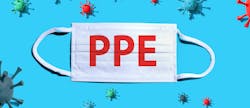Submit your questions: email: [email protected]
QWe recently began using self-seal peel pouches in our clinics. The OR supervisor insists that everything packaged in a peel pouch be double packaged. He claims this is required by the Association of periOperative Registered Nurses (AORN) and the Association for the Advancement of Medical Instrumentation (AAMI). Do you have any information regarding double packaging a self-seal pouch? I’m concerned that the paper on the pouch would face the plastic, preventing the steam from reaching all the contents in the inner pouch. Is it safe to double pouch these pouches?
A
There are no AAMI or AORN recommendations that state you must double peel pouch items for use in the operating room (OR). Both AORN and AAMI state that you should follow the manufacturer’s instructions for use (IFU) for any packaging materials you utilize. Their recommendations also advise that if a hospital chooses to double peel pouch, they must be sure that the manufacturer has validated their pouches for double pouching. Many peel pouches have not been validated for double pouching. I know of no peel pouch manufacturer that requires double peel pouching for the use of their products. As part of Food and Drug Administration (FDA) clearance, packaging manufacturers must provide validation that their product allows for sterilant permeation to achieve sterilization of the package contents. They must also provide validation of the product’s ability to maintain sterility until the point of use.
Some ORs want certain items double pouched for sterile presentation. This might include multiple small items or instruments that might present a challenge in aseptic presentation, and thus may need to be held together or contained while being passed off to the sterile field. I find that many hospitals are unnecessarily double pouching all items as a force of habit while others claim it is necessary to prevent tears and punctures and to maintain sterile integrity. If you are double pouching due to tears and punctures, you may want to investigate your packaging techniques. Tearing is often associated with the following issues:
1. Packaging oversized or heavy objects in a peel pouch
2. Using the inappropriate size pouch for the item(s) being packaged
3. Failing to use packaging aids such as tip protectors on sharp tip instruments or devices with protrusions
4. Using lightweight, poor quality peel pouches for “perceived savings”
If you are double pouching all items to ensure sterility maintenance and using a less expensive and lower quality pouch, you might want to explore other peel pouches that provide a multi-layer of heavier polymer (plastic) and a heavier paper weight for added protection and superior performance. While the individual pouch cost might be slightly higher, use of such could, in the long run, cut your peel pouch inventory usage in half and result in real significant savings by reserving the practice of double pouching strictly for those items requiring such for aseptic presentation.
If you continue with double pouching, be certain that you obtain instructions from the pouch manufacturer. You will want to know what the acceptable sizing is for the inner and outer pouch. The inner pouch will need to be smaller, fitting freely within the outer pouch. Inner pouches must never be folded in order to fit in an outer pouch. Inappropriate sizing could impede the efficacy of the sterilization process and the performance of the packaging. Some peel pouch manufacturers provide a guide that specifies all acceptable inner and outer pouch size combinations.
QWe are evaluating adenosine triphosphate (ATP) monitoring systems to use for testing our surgical instruments and other medical devices to verify that they are clean. I am confused about what the passing number should be for an ATP detection test. Of the devices we have looked at, they each have different pass/fail levels. I consulted with our infection control officer and he said that while ATP testing is used in our Housekeeping and Food Service departments, she doesn’t feel that ATP is necessarily a good test for monitoring surgical instruments. I know many of my colleagues in other hospitals are using ATP testing in their CS departments to monitor the cleaning of surgical instruments. I am a bit confused by the mixed information I am receiving on the use of ATP. What are your thoughts on this?
A
Adenosine triphosphate (ATP) is a chemical that is produced in every living cell. So, its presence on an item tells us that there is something on that surface that is, or was recently, alive. An area or surface to be tested is swabbed, the swab is placed into a holder containing a chemical solution that prevents ATP degradation and is then placed into an illuminometer, which determines the detection of ATP residual in relative light units (RLUs), which are emitted from the swab. Acceptable RLU values vary from system-to-system and currently there is not a standard pass/fail unit of measurement across the various manufacturers’ ATP testing systems. One manufacturer might say that a pass would be an RLU below 25 while another might claim a pass would be anything below 250 RLU.
ATP testing has been around for many years. It originated and is still used to effectively monitor equipment and surfaces in the food and environmental industries. In these industries, highly-invasive medical devices are not used or tested and the measure of “clean” does not have the same impact. ATP is not present in viruses nor is it present in components such as protein, carbohydrate, hemoglobin, lipids, and the like, which are the precise soils we confront in sterile processing when cleaning invasive medical devices and surgical instruments. ATP degrades over time and once it degrades it cannot be detected. This means it is possible to get a pass reading in ATP detection yet still have visible organic soil remaining on an object.
We obviously would not want to use a medical device in surgery with any residual soil remaining on it. I believe it would be more appropriate to use actual organic soil detection testing devices on invasive medical devices and surgical instruments – these devices are capable of detecting the most common organic soils found on medical and surgical devices such as protein, carbohydrate, hemoglobin, lipids and the like.

Ray Taurasi
Ray Taurasi is Principal, Healthcare CS Solutions. His healthcare career spans over five decades as an Administrator, Educator, Technologist and Consultant. He is a member of AORN, SGNA, AAMI and a past president of IAHCSMM. Taurasi has been a faculty member of numerous colleges teaching in the divisions of business administration, nursing, and health sciences. He is the author of numerous articles and textbook chapters; he is a frequent speaker at national and international healthcare conferences.
Note to readers from Ray Taurasi - In 2021, my life’s career path will transition to one of new opportunities and adventures. As a result, after nearly 19 years and 225 CS Solution columns, this edition will be my last.
“All changes, even the most longed for, have their melancholy; for what we leave behind us is a part of ourselves; we must die to one life before we can enter another.”– Anatole France
I wish you and your loved ones a healthy and joyful holiday season and a beautiful New Year! God Speed, Ray
https://www.facebook.com/pages/category/ Local-Business/Healthcare-CS-Solutions-128857 3061153887/ • email: [email protected]





